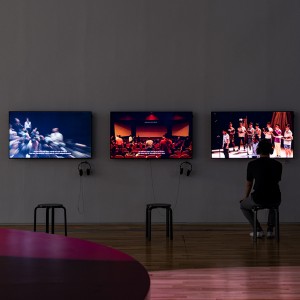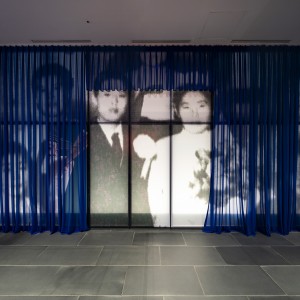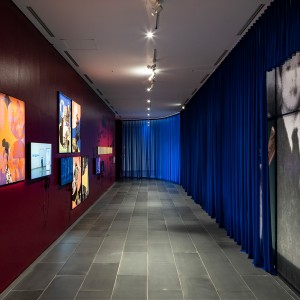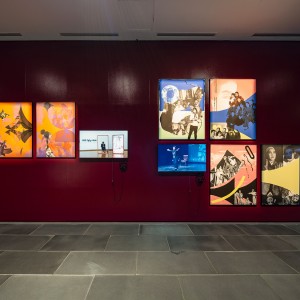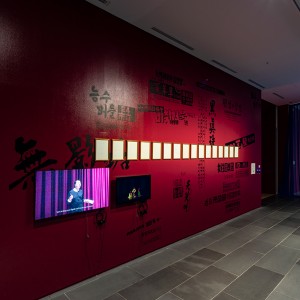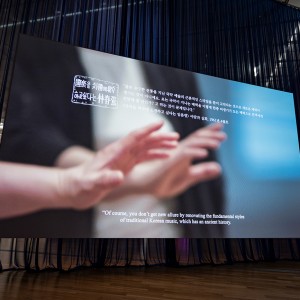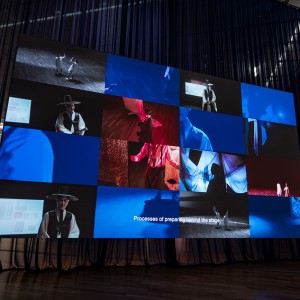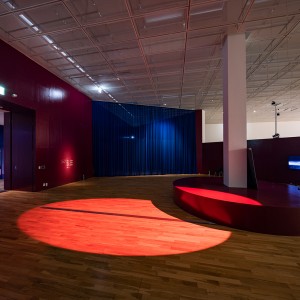siren eun young jung
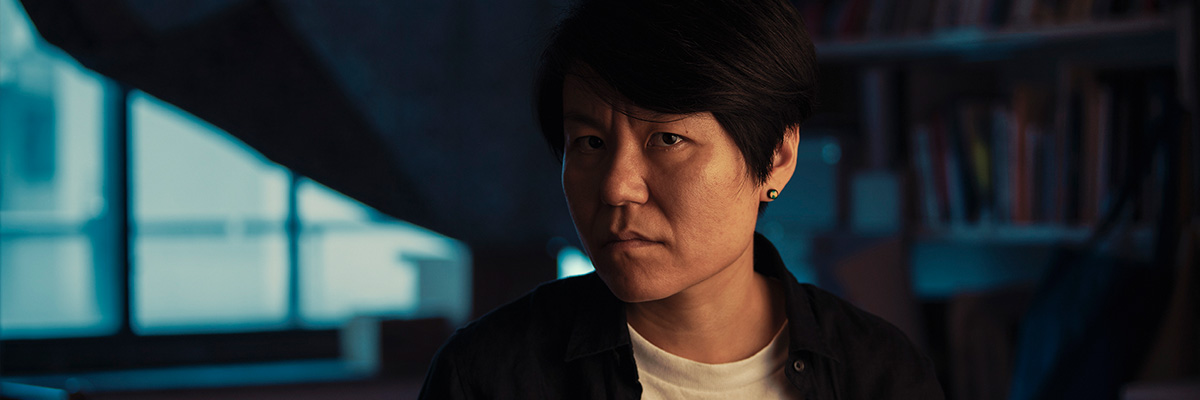
Interview
CV
<Selected Solo Exhibitions>
2018
Anomalous Fantasy-Japan Version, TPAM, KAAT, Yokohama, Japan
2017
Wrong Indexing, NTU CCA Singapore
2016
Anomalous Fantasy, Namsan Art Centre, Seoul
2016
Wrong Indexing, Sindoh Art Gallery, Seoul
2015
Trans-Theatre, Art Space Pool, Seoul
2014
(Off)Stage/Masterclass, TPAM, KAAT, Yokohama, Japan
2010
Rehearsal, Platform SlowRush, Songdo International city, Korea
2007
The Passenger: Traveler’s Book, Seoul-Frankfurt-Madrid-Paris-London-Seoul
2006
The Wandering Diseases, brainfactory, Seoul
<Selected Group Exhibitions>
2018
Proregress, Shanghai Biennial, Shanghai, China (upcoming)
2017
Urban Ritornello, Ilmin Museum of Art, Seoul
2017
Asian Diva: The Muse and The Monster, Seoul Museum of Art (Buk Seoul Branch), Seoul
2017
2 or 3 Tigers, Haus der Kulturen der Welt, Berlin, Germany
2017
Score, Daegu Art Museum, Daegu, Korea
2016
Polyphonies, Centre Pompidou, Paris, France
2016
Gestures and Archives of the Present, Genealogies of the Future, Taipei biennial 2016, Taipei, Taiwan
2016
The 8th Climate: The 7th Gwangju Biennale, Gwangju, Korea
2016
As the Moon Waxes and Wanes, National Museum of Modern and Contemporary Art, Korea, Gwacheon, Korea
2016
Discordant Harmony, Kuandu Museum of Fine Art, Taipei, Taiwan
2016
Staging Film, Busan Museum of Art, Busan, Korea
2015
Discordant Harmony, Hiroshima City Museum of Contemporary Art, Hiroshima, Japan
2015
ASIA TIME, The 1st Guangdong Asia Biennale, Guangdong Museum of Art, Guangzhou, China
2015
8th Asia Pacific Triennial of Contemporary Art, QAGOMA, Brisbane, Australia
2015
FANTasia : Asia Feminism, Seoul Museum of Art, Seoul
2015
The Future is Now, La friche Belle de Mai, Marseille, France
2014
The Future is Now, MAXXI, Rome, Italy
2014
Ghosts, Spies, Grandmothers : Seoul Media City 2014, Seoul Museum of Art, Seoul
2014
Traditional (Un)Realized, Arko Art Center, Seoul
2014
Post-Movement: Night of Café Mueller, Kuandu Museum od Fine Art, Taipei, Taiwan
2014
Something in space escapes our attempts at surveying, Württembergischer Kunstverein, Stuttgart, Germany
2013
Where The Ends Meet, Gallery Houg, Lyon, France
2013
Tell Me Her Story, Space C, Seoul
2013
Hermes Foundation Missulsang, Atlier Hermes, Seoul
2013
Learning Machine, Nam June Paik Art Center, Yong-in, Korea
2013
The Songs of Slant Rhyme, Kukje Gallery, Seoul
2013
Festival Bo:m, Mary Hall, Sogang Univ., Seoul
2012
Play Time, Culture Station Seoul 284, Seoul
2011
The New Epicenter, Womin Art Center, Cheongju, Korea
2010
Perspective Strikes Back, Doosan Gallery, Seoul
2010
Trans-media-scape, The 12th International Women’
2010
Going, 2010 Seoul LGBT Film Festival, Seoul
<Awards>
2015 Winner of 2015 Sindoh Art prize
2013 Winner of 2013 Hermes Foundation Missulsang (Art Prize)
<Residencies>
2017 Artist Residency Program at NTU Center for Contemporary Art, Singapore
2016 Artist-in-residancy at TPAM(Performance Art Meeting in Yokohama), Kobe-Yokohama-Tokyo, Japan
2014 Artist-in-residency, SeMA Nanji Residency, Seoul City Museum of Art
2010 Artist-in-residency, Gyoenggi Creation Center, Gyoenggi Art Foundation
2005 Artist-in-residency, Ssamzie Studio Program, Ssamzie Space
<Collections>
National Museum od Modern and Contemporay Art, Korea
Daegu Art Museum, Korea
Busan Museum of Art, Korea
Seoul Museum of Art, Korea
Museum of contemporary art Busan, Korea
KADIST, Sanfrancisco, US
Critic 1
Deferred Histories – Telling an Unpleasant Truth On siren eun young jung’s practice queering South Korea’s Cultural History
Ute Meta Bauer (Founding Director, NTU Centre for Contemporary Art Singapore)
Informed by gender politics and historical acts of resistance siren eun young jung’s research based artistic practice engages across a wide range of mediums such as films, photography, performance and installation. In 2013 she was awarded the Hermès Foundation Missulsang prize, for her video work Act of Affect produced in that year. This is her first work that I encountered and it made me curious about her inquiry into the history of Yeoseong Gukgeuk, a traditional theatrical genre created and performed solely by female protagonists. During her recent artist-in-residence at the NTU Centre for Contemporary Art Singapore I became more familiar with her long-term commitment to this particular theatre form that reached its peak in the fifties, the artist’s advocacy for its central characters, and the repression and exclusion from official histories of the particular circumstances that lead to Yeoseong Gukgeuk emergence within Korea’s post-occupation cultural history following WWII.
To understand the significance of jung’s artistic practice it is important to position her work within Korea’s cultural, social, and political history to which her entire oeuvre contributes. Born in the mid-seventies, as Jung Eun Young was a teenager when South Korea saw a period of violence when students and civilians who were opposing to the South Korea autocratic rule at the time, were tortured and killed. Although at that time still young, these incidents left its mark in jung’s childhood memory and having lived through these events impacted her shaping years becoming an adult. Amongst many controversial events that jung witnessed, the years lead-up in preparation for the 1988 Olympic Summer Games hosted by South Korea was a notable one. Being the second Asian country to host a Summer Olympic, the 1988 Seoul Olympics was an opportunity for South Korea to gain international attention and showcase for their economic growth1. However, the means to prepare the country for the event included the hiring of thugs to forcibly remove the poor residents of Sanggyedong for the redevelopment of land. Violence broke out as the residents resisted but construction took place anyway, demolishing houses still filled with possessions.2 Others were locked away in closed institutions, or forces in to unpaid work in factories and construction sites, thousands were mistreated and died. All this was known to the government, but never lead to any prosecution.
The well-known 1987 student uprising in the aftermath of the massacre of Gwangju3, the June Democracy Movement eventually caused the overthrow of the Fifth Republic of South Korea. It was indeed the after-effects of these traumatic events that prompted changes in attitudes amongst universities students. Protest groups and feminist assemblies were formed, that challenged the traditional standards of South Korea’s societal norms and hierarchies and the call for change swelled beyond the nineties. The neglect of the government to implement democratic involvement, the lack of transparency in the necessary political process continues to cause frustrations in the population. Until today, South Korea has one of the worst cases of gender inequality when it comes to salaries or rights at the workplace for a high percentage of female workers4.
In 1994, jung became involved in the sprouting young feminist movement within her university campus. As part of a political and social gesture these students gave themselves new names, breaking with their given predetermined societal roles. In the year 1994, using this important rite of passage, jung decided to assign herself a name that would be particular to her and express what she felt. She refused to be profiled by the existing Korean patriarchal and class structures and she deliberately chose “siren” as for “dangerous woman/creature”. Referencing Greek mythology as an act of resistance and empowerment she would write her new self-given name in lower case: siren eun young jung. The name appealed to her as the “sirens” were known for their powerful, deceptive voices, that jung seeked to apply from her position as an artist in the act of “seducing” through compelling work, to those listening to her. In addition, this name would not reveal her gender, her ethnic nor class background and it was for her a political strategic gesture to position herself in a western male centric society as a queer Asian artist5.
While in the United Kingdom, jung eventually met feminist art historian Griselda Pollock, who accepted her into the MA programme at University of Leeds, where she graduated in 2004 with a Master in Feminist Theory and Practice in Visual Art. Pollock cautioned her that feminism is not just theory, but a practice and encouraged jung to translate her thoughts and wishes into creative work. After she returned to Korea, she started to develop works of art that were based on her personal experience and that of the women around her and from 2007 she participated in a community project in Dongducheon, a city where a United States military base was located. There she came across Korean women working as prostitutes whose patrons were American soldiers. Through this first involvement as a researcher and artist with a particular female community she was confronted with the daily lives of sex workers.
This marked the beginning of her of interests to study women’s predicament serving in the particular role of entertaining men. Through a senior colleague in cultural studies she eventually came across the genre of the Yeoseong Gukgeuk an all-female theatre genre that had its peace in the fifties right after WWII. The personal encounters with key protagonists developed into a long-term inquiry in the lives of these performers and the particular historical circumstances that led to the invention of this new form. Initially to serve soldiers during Japanese occupation, a vast number of Korean women were trained in Korean kisaeng schools ruled by the Japanese Government called Gwonbeon6. The women were trained to entertain the Japanese army through musical play and dance, a clear reference to the role that Geishas have in Japan7. There existed a much larger scheme of forcing women to serve the Japanese Army as “Comfort Women” in Japan Military Brothels in Korea or as it referenced more directly, as sex slaves. It was jung who showed me last year a bronze sculpture depicting a young woman sitting on a chair, that was installed on the sidewalk near the Japanese Embassy in Seoul as a visible reminder of the “Comfort Women”, whose existence is still not officially acknowledged by the Japanese Government. After the end of the Japanese occupation, the entertainers trained in the Gwonbeon became jobless. They joined organized the Korean Women Traditional Musician Association and became part of a new Korean music industry.8 Still stigmatized and discriminated, they developed their own theatrical form called Yeoseong Gukgeuk. Since more than a decade, jung has focused in her work on this dying art form, the trajectories of individual performers, and the socio-political role of these once highly popular form of entertainment. Yeoseong Gukgeuk became the core of her artistic inquiry and agency as a longterm research and she pursued a Doctoral Degree in Fine Art at Ewha Womans University in Seoul with a dissertation titled “The Politics of Gender and the Aesthetics of Dissensus: With a Focus on the Yeoseong Gukgeuk Project”. Through this body of work, she points to the unique history of its significant legacy as well as to the prominence of its most adored performers, that she considers invisible in the official cultural narrative of her country. She collected and presented documents, interviewed key protagonists of the genre, whom she featured in performances scripted by herself with collaboration of the performers. In its most current iteration Deferral Theatre (2018) she expanded this even further into an active agency transforming these historical cultural practices together with a new generation of performers into a potential future existence. As the initial Yeoseong Gukgeuk performers are coming to age, jung engages with this new generation which consists of only a few female performers who continue to be trained in this art form9. If prior jung was studying the history of Yeoseong Gukgeuk, arguing for its place in South Korea’s National culture history she now is part of calling for its future existence. jung herself became part of the genre and its continued history.
The Yeoseong Gukgeuk is a reference to South Korea’s traditional theatre form Pansori.10 Until today, preserved as a national asset, Pansori is a Korean pre-modern tradition of musical storytelling and involves a singer and an accompanying percussionist. It took place in private homes to entertain the Korean elite although it is rooted in everyday Korean culture. The Yeoseong Gukgeuk was set to be performed in existing theatres shifting the intimate way of performing Pansori in private to a public accessible format, in a Hellenistic architectural structure with a clear separation of stage, performer and audience. It also attracted a different audience, mainly female, ranging from housewives to sex workers, who saw this theatre as a liberating space to breathe and interact. It is no surprise that Yeoseong Geukguk also gained popularity amongst schoolgirls and it challenged heteronormative relationships within a patriarchal society. This particular aspect gained the attention of jung whose interest was in the history of feminism in Korea.
Ironically, Yeoseong Gukgeuk points to another Asian tradition in Japan itself, the Takarazuka Revue11 that also features female performers. Seen in a wider historical context, both genres counteract the tradition of male performers playing female roles in traditional theatres across Asia.
jung also was interested in the wide reception of these performers that gained celebrity status in the hay-day of the Yeoseong Gukgeuk, their coverage by women magazines in their off-stage life as well, and their huge group of followers.
From 2008 until 2011, jung’s work focused on a particular star, Cho Geum-aeng. Going through her private photo album during an interview, she came across a photo that caught her attention. It was a staged wedding photograph of Cho and a fan which featured them as bride and groom along with Cho’s theatre members and friends to pose as guests. Especially the fact that both Cho and her fan were married to men caught jung’s interest. Although Cho was married three times and mothered three children of three different surnames, this peculiar photo was the only wedding photograph she kept in her personal archive, wiping the traces of her three husbands. Upon learning about Cho’s marriage history and the fictional aspect of this image, the photograph ruptured jung’s understanding of archived photographs as evidence of truth. It led her to investigate further with an understanding of how visible and invisible histories needed to be explored and connected. The trajectory of the performer’s life became the topic for her next inquiry to shed light on the hidden lives of lesbian and transgender community in South Korea.
In that way, the practice of the Yeoseong Gukgeuk is therefore important to trace South Korea’s queer history in the 1950 – 60s. Even though Yeoseong Geukguk is tied to post-occupation history, it was rather deliberately left behind when Korea began building its new national identity. Focused on promoting economic development, fighting poverty and strengthening national power, Yeoseong Gukgeuk, which connected mainly to its female audience was not favored by the new Cultural Properties Administration, an office established in 1961 under President Park Chung Hee12. The office was responsible for all processes related to heritage management, and determined definition, selection, conservation and the promotion, defining new national culture and identity. It prioritized the monumental, the grand, and the old tradition of patriarchy and heteronormative moral. By 1990s only a few Yeoseong Gukgeuk troops remained. In one of jung’s videos it is stated by a performer this may have been different if they would have developed an internal system of trainees and performers learning directly from the older performers. However, as the initial generation of performers chose this occupation due to the specific and often painful circumstances within their own lives, how to communicate this to a next generation shaped by a different and modernized Korean society? The complexity of societal hegemonies as well as gender inequalities and how these are inscribed in everyone’s personal history is reflected in jung’s complex research based artistic practice that engages different archival collections of photographs, news clips, interviews with performers by the artist that over the years shaped her deep understanding and identification with the challenging history of this particular women, as well as societal condition for women per se. Persistent in her inquires unfolding layer by layer, her perspective and method of deconstruction and reconfiguration of documents and all kind of materials applies feminist and queer theory as a tool. Her different art installations and body of works revolve around the stories and histories of these performers while featuring their qualities as creative practitioners which makes them peers. In addition to utilizing diverse archival material including footage of interviews, she also took photographs of performers in gender traversing roles. However, many performers were uncomfortable in front of the camera and preferred performing in real time, on stage. This resulted in two works (Off)Stage and Masterclass that she premiered in 2012 at Culture Station Seoul 284.
The single channel video (Off)Stage: Cho, geumaeng(2012), is in search of this first generation nimai13, who passed away. Through the video and exhibiting reference material jung marks the absence, the disappeared voice, that will not anymore be able to speak about this moment in time, her experience as a performer, the specificities of her community that shaped this unique theatre form and the particularities that determined their lives. Through her work jung asks, how such deliberately hidden and ousted history can be re-animated, how the testimonies and faded photographs be re-inscribed in archival memory to fill the void that each dying protagonist creates? How can these painful and at the same time creative individual histories of women shaped by the Japanese occupation and the Post-WWII period finally become visible and officiated as part of South Korea’s national history?
Through her art works in a diversity of contexts ranging from exhibitions to research presentations to recorded and live performances in theatres, jung is able to draw an intimate history of the creativity and playful inventiveness of these female performers, who often lived a transgender life not only on stage. At the same time, she highlighted the success and wide visibility of the Yeoseong Gukgeuk in its hay-days that spoke to the repressed desires of their female audiences.
Initially unintended siren eun young jung became an archivist of this movement, but over the years the artist not only in her work developed solidarity with the challenging situation of the few performers addressing the isolation of queer people in South Korea. Her deliberate non-linear way of archiving the history of Yeoseong Gukguek’s is her attempt to project the fact that recounts of what had taken place and should be part of national history appeared just in fragments of information, and had to be carefully re-constructed and inevitably overlapped as each performer lived through variant experiences. Thus, mapping these historical events normatively is nearly impossible and could be challenged as inaccurate. The lack of sub theme and linear logic is also tied in with the fact that jung is interested in taking the “given” apart, dissecting and reconstructing it through attempts of acquiring and enquiring the truth through different and creative means. For jung, her recent invention of Deferral Theatre(2018) as a performative tool situating the historic narrative directly in a theatre setting, not only stands as a place where the performers have spent most of their professional lives, but it provides also liberating space to engage with the traumatic history of women in the company of others. To continue the practice to choose one’s own imagined role and desired gender could be seen as the creative and collective act of artists to gain a different self-understanding. In spite of presenting the curious specificities of Yeoseong Gukgeuk that makes this format so unique, jung also sheds light onto the repressed histories of systemic violence women endure in patriarchal societies, including in her own country. The artist’s practice is to be understood as advocacy not only for this particular genre, its performers and their history. Through this long-term commitment to the subject of the Yeoseong Gukgeuk and the women drawn into this by the specific historic circumstances in her country, she indeed highlights its potential and reshaped future for a queer and LGBT community today, and the continued demand and struggle to have a political voice and rights in any society.
Entitled Deferral Theatre, jung’s project for the Korea Artist Prize 2018, is therefore a continuation of her decade long effort to revitalize the interest in the disappearing artform of Yeoseong Gukgeuk. This new work is a different take onto the Yeoseong Gukgeuk, it is an act to “defer its death sentence” as jung herself describes it. This iteration of her ongoing dedication to Yeoseong Gukgeuk marks a different approach then, yet it shares once more the artist’s insistence to problematize “gender normativity” and to highlight the difficult socio-political of “marginalized” groups within a society and the artist joining the call for equality opportunity and rights, as well as freedom of expression for everyone. In a time where a government establishes blacklists of artists as it happened recently in South Korea under President Park Geun-hye and her Minister of Culture, the urgency of such work in all its many layers becomes even more imperative14.
In her recent work Deferral Theatre, three theatre practitioners are interviewed voicing their thoughts about their theatrical genre. The internalization of performing male roles and improving their male acting, the boundaries between acting as men on stage and their offstage life as females began to blur. Surrounded by female colleagues and a female audience they inevitably developed romantic feelings for each other.
In a tireless effort jung restages, screens and records into an invisible past and projects into a potential future for queer theatrical forms—and therefore queer life. jung not only confronts us with the fact that history includes unpleasant truth that lingers like a shadow near its visible part. jung also addresses the lasting dominance of a patriarchal system in South Korea that degrades women into supporting roles in public and private life. Like the sirens, as a queer “enchantress”, jung uses her artistic language as the seductive voice, to lure us into the dangerous and unpleasant waters of historical truth.
1. Horton, P. & Saunders, J., “The ‘East Asian’ Olympic Games: What of sustainable legacies?”
The International Journal of the History of Sport, 29(6), 2012. Retrieved 20 Februaruy 2015.
2. George Katsiaficas, Asia’s Unknown Uprisings, Volume 1: South Korean Social Movements in the 20th Century, PM Press, 2012, p. 277.
3. George Katsiaficas (20 March 2012). Asia’s Unknown Uprisings, Volume 1: South Korean Social Movements in the 20th Century. PM Press. pp. 277~. ISBN 978-1- 60486-457-1. Retrieved 11 February 2013.
4. https://www.usnews.com/news/bestcountries/slideshows/the-10-worstcountries-for-genderequality-ranked-byperception?slide=9
5. Based on an email conversation with the artist
6. siren eun young jung, Hyoshil Yang, Young Ok Kim, Tari Youngjung Na, Haejin Pahng & Sohyun Ahn, Trans-Theatre:Yeoseong Gukgeuk Project 2009 – 2016, Forum A, 2016, p. 318.
7. https://www.history.com/news/comfortwomen-japan-militarybrothels-korea
8. In 1948, the Korean Women Traditional Musician Association was founded to support and provide these female performers with liberal work and creative opportunities.
9. A musical play based on pansori, a Korean traditional style of music
https://www.ntok.go.kr/en/Changgeuk/Main/Index
10. Pansori is a Korean genre of musical storytelling performed by a singer and a drummer. Originally a form of folk entertainment for the lower classes, pansori was embraced by the Korean elite during the 19th century.
11. The Takarazuka Revue is a Japanese all-female musical theater troupe based in Takarazuka, Hyōgo Prefecture, Japan. Women play all roles in lavish, Broadway-style productions of Westernstyle musicals, and sometimes stories adapted from shōjo manga and Japanese folktales.
https://en.wikipedia.org/wiki/Takarazuka_Revue
12. Andrew David Jackson(ed). Key Papers on Korea: Essays Celebrating 25 Years of the Centre of Korean Studies, SOAS, University of London, 2013, pp. 253~274.
13. One of major charaters of yeoseong gukgeuk;the hero who embodies both gallantry and romantic masculinity.
14. Based on an email conversation with the artist: even under the new govern of President Moon Jaein, the court announced that there will be no disciplinary consequences for those involved in creating this blacklist in South Korea’s Ministry of Culture.
Critic 2
Songs of Individuals1
Sunghee Lee (Curator and former director of Art Space Pool)
siren eun young jung has recalled to the present a rapidly disappearing Korean traditional theater performance genre that is now nearly forgotten, sought to pinpoint the genre’s position within the lineage of contemporary art, and continuously refined her inquiry into the genre to draw out diverse discussions in artistic, cultural, political, and social contexts. Beginning in 2008 and progressing over a period of nearly ten years, the artist initiated and carried out Yeoseong Gukgeuk Project, examining yeoseong gukgeuk—a genre of Korean opera and musical theatre performed exclusively by women (both male and female roles) that emerged in the late 1940s and peaked in popularity as a performance genre in the 1950s post-Korean War period. She proposes a queer interpretation of the genre via a gender politics that embraces not only the “on-stage” of yeoseong gukgeuk but also the “off-stage” of the performers’ daily lives by examining yeoseong gukgeuk’s agents, i.e., its performers (specifically, those who perform the male roles) and its audiences.
As an initial matter, I recommend siren eun young jung for Korea Artist Prize 2018 because she is an artist whose practice is sincere and yet steadfastly practical. Swimming against the unyielding current of the present, the artist has slowly but steadily breathed new life into the history of yeoseong gukgeuk and conceived new artistic productions via a seamless synthesis with contemporary art by immersing herself into the art and lives of non-subjects that have not been recognized in official histories and by listening to, documenting, and questioning their stories in the most intimate of settings. The artist treasured her memories of meeting with elderly yeoseong gukgeuk performers—from her instant enchantment the first time they met to the (at times) uncomfortable sentiments that she felt while sharing in their everyday lives. Initially proceeding by documenting the performers’ voices, the artist then attempted to go beyond her personal experience and sought to engage in a re-contextualization of yeoseong gukgeuk. At first, her works comprised scenes of the performers’ makeup and rehearsal sessions and interviews with the performers. In this manner, she created a kind of “yeoseong gukgeuk archive,” playing the role of a documentary artist while fastidiously maintaining a proper distance from the objects of documentation. She then went on to create new stages and videos for the yeoseong gukgeuk performers, in the process experimenting with artistic intervention and aesthetic and artistic transformation. Throughout these evolving processes and over an extended period of time, the artist did not strategically target a specific goal, but instead repeatedly paused to carefully and constantly question herself as to her reasons for representing yeoseong gukgeuk. Thus, this project was never intended to have a specific point of completion. Instead, it serves as a record of the artist’s long journey to find answers amid its incompleteness.
Through Yeoseong Gukgeuk Project siren eun young jung approaches gender politics from the perspective of unanchored gender. The artist discovered that the yeoseong gukgeuk performers ultimately “alternated” their gender and that gender is something that emerged into view at different stages of their lives, and she recalled this process through oral statements, theory studies, photographs, video works, and performances. An elderly performer on stage in (Off) Stage (2012) reflects on her personal stories about how a female performer with a male role in yeoseong gukgeuk had to be a man off stage in order to be a dashing man on stage. They not only practiced acting techniques in order to appear like debonair men, but also talked, walked, and acted like men in their daily lives in order to train their bodies and acquire the requisite attitude. Yet, as revealed in Masterclass (2010, 2012, 2013), which depicts a protégé’s lesson where the male role is passed down to the younger generation, the man that yeoseong gukgeuk was trying to realize was exaggerated to such a degree such that he was nothing like the men in reality, thus twisting the common perception of gender. In other words, the work presents the masculinity that the performers were trying to “embody” both on and off stage as a type of fantasy; nevertheless, it prompts us to reconsider the mindset itself that acknowledged and accepted such gender characteristics in the first place. Notably, in the works noted above, the artist prepared stages for yeoseong gukgeuk performers upon which they could reveal their previously unspoken stories, but in her lecture performance Gender Bender Fencers (2014, Arko Art Center; 2017, Haus der Kulturen der Welt), the artist shifted roles to herself became a performer who put forth discussions of a new gender that is located outside the precepts of binary gender.
In her solo exhibition Trans-Theatre (2015, Art Space Pool), the artist took image montages extracted from the archives that she created and organized them under the title “Public yet Private Archive (2015).” Sohyun Ahn, the curator of this exhibition, explains that in a situation where no definite center is established, the tendency of the images that the audience reads is revealed simultaneously as being dependent on certain social customs that are inscribed in people and also as subverting such customs, and this tendency is a common denominator between gender formation and archive exhibitions.
At Namsan Arts Center, siren eun young jung showcased Anomalous Fantasy (2016), which was her first formal theaterbased work and thus signaled a new phase of Yeoseong Gukgeuk Project. In this work, the artist retraced her initial intent to focus on the background of yeoseong gukgeuk’s birth and its “gender play,” and pondered “what is left behind after its decline.” Through the fate of Nam Eun Jin, a member of the last generation of yeoseong gukgeuk male-role performers, and the voices of G-Voice, an amateur gay chorus, she attempted to “awake the Dionysian aesthetics that remain in the unstable lives of those who were not be able to reach a ‘proper’ position in this society.” (Artist’s Note). Anomalous Fantasy examines the multiple reasons for yeoseong gukgeuk’s failed history (specifically, its deliberate exclusion from male-centric modernization, thus becoming the “other”) from a contemporary perspective and actively confronts today’s nuanced gender politics.
Approximately one year has passed since I initially wrote this recommendation letter. I would now like to now return to where I left off and share my thoughts on siren eun young jung’s work Deferred Theatre (2018), which was presented at the 2018 Korea Art Prize exhibition at MMCA Seoul. Along with her continuing process over more than ten years of approaching, observing, and documenting yeoseong gukgeuk and bringing it into the present, I understand this work’s role as one that compels the artist to ask herself, time and time again, why she has to undertake Yeoseong Gukgeuk Project, and specifically why she has to do so at this particular moment in time. Set in the background of a theatre, jung asks three performers—a male-role performer from the last generation of yeoseong gukgeuk, a singer of Korean opera, and a drag king—their opinions about the genres that they work in, and then intersplices their contrasting answers in a manner that has the effect of further raising new questions. The performers express their passion for or captivation by their genres, but their attitudes toward these genres are divergent and, indeed, at times almost diametrically opposed to one another.
In particular, as the artist directs pointed questions toward a yeoseong gukgeuk performer whom she has spent quite a long time with, she seems to invite a critical introspection about the performer and the artist, as well as about the exact reason they have undertaken a series of projects to represent yeoseong gukgeuk. In response to the artist’s questions about how yeoseong gukgeuk will be able to survive in the future and whether it is actually worth preserving, male-role performer Nam Eun Jin answers that it may be possible if done well with a proper flow so that audience members can empathize with it. However, the artist responds, “I don’t think it would be possible.” The performer wishes that, as one of many diverse facets of Korean traditional culture, the disappearing genre of yeoseong gukgeuk could continue on. However, by juxtaposing this with the rather cynical attitude of gagok changja (singer) Park Minhee, who performs traditional Korean gagok within a new contemporary frame and states matter-of-factly that “gagok has no position whatsoever” and “it’s really no big deal even when something that was beautiful in one age disappears,” the artist explicitly reveals the two performers’ contrasting viewpoints on tradition. This juxtaposition certainly recalls the disparity between one viewpoint that identifies tradition with history and understands it as fixed, thus considering it either as something to unconditionally deny or otherwise defend, and another that understands tradition as a continuum that has been arrived at through constant evolution.2
The scenes also intermix the male-role performer and drag king Azangman. The artist carefully constructs a discussion about gender politics in between the male-role performer, who has inherited and practiced exaggerated gestures and a masculine voice to represent an imaginary masculinity in traditional yeoseong gukgeuk, and the drag king, who uses her singing on the stage as a performance platform and thus as a means to liberating her sexual identity. However, even though the intention of the artist is to inquire about and discuss tradition and the present as well as gender politics, what these performers express is not so much a macro perspective on tradition and history than something more like a confession in which they perform the genres that are essential for them, and they do so in order to tell stories about life and to make and sing private and trivial songs. In fact, this overarching confession resonates more powerfully than any of the interviewees’ individual opinions.
The work then depicts documents and video clips from the yeoseong gukgeuk archive that the artist has collected and a clip from an interview with Cho Young Sook, a first generation yeoseong gukgeuk performer. Finally, the artist reads excerpts of a historical document from the modern male-centered gukak field that intentionally denigrated and attacked yeoseong gukgeuk. While furiously criticizing the activities of all-female troupes, even citing the proverb “when a hen crows, that family will be ruined,” the document concludes with an admonition that “male and female changguek performers alike must create and cultivate their skills, thus endeavoring to establish traditional changgeuk.” Subsequently, the artist removes the words “male and female” and “tradition” from the preceding sentence and asks again, “is there any reason [why yeoseong gukgeuk] should exist?” to which the yeoseong gukgeuk performer answers, “I wish that what I like would survive, it is a personal wish.” However, the next scene again displays an article that reveals the fierce volition of the yeoseong gukgeuk performers who stood up to the male-centered gukak field. Deferred Theatre deconstructs issues of tradition, the present, and gender through interviews with three performers but only alludes to the possibilities of how to reconstruct them. As the artist traces back the history of yeoseong gukgeuk and critically examines the present, she seems to have located a point of synthesis somewhere in between the passionate affect where the on-stage and daily off-stage lives fused together among the first generation of yeoseong gukgeuk performers and the affect embracing the vague dreams of the last generation of male-role performers.
Translation: Sunghee Lee


